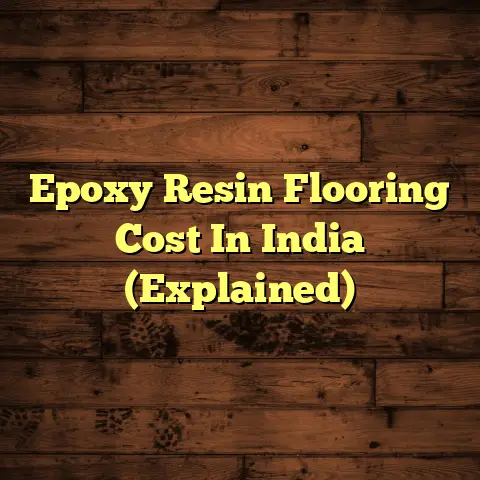Laminate Flooring Health Risks? (5 VOC Alerts!)
Ever notice how laminate flooring is like that impeccably dressed friend who always shows up to parties with a dazzling smile?
But might just have a raucous party of volatile organic compounds (VOCs) brewing beneath their polished surface?
I know, it sounds a bit dramatic, right?
But as a flooring contractor who’s seen it all (and sniffed it all, unfortunately), I’m here to tell you there’s more to laminate than meets the eye.
Let’s dive deep into the hidden world of VOCs and uncover the potential health risks lurking in your seemingly harmless laminate floors.
Section 1: Understanding Laminate Flooring
Laminate flooring has become a superstar in the flooring world.
Why?
It’s cost-effective, stylish, and can mimic the look of hardwood or tile without breaking the bank.
I’ve installed miles of this stuff, and clients love it!
But what exactly is laminate flooring?
It’s a multi-layered synthetic flooring product fused together through a lamination process.
Think of it like a high-tech sandwich:
-
Wear Layer: The top layer, a transparent coating that protects against scratches and wear.
-
Design Layer: A high-resolution photographic image that gives the flooring its realistic wood or tile appearance.
-
Core Layer: Typically made of high-density fiberboard (HDF) or medium-density fiberboard (MDF), providing stability and impact resistance.
-
Backing Layer: The bottom layer, providing moisture resistance and balance.
Now, here’s where things get interesting.
The manufacturing process often involves adhesives, resins, and other chemicals.
And guess what these can release?
You guessed it: VOCs!
VOCs, or Volatile Organic Compounds, are chemicals that evaporate at room temperature.
They’re found in tons of building materials, including our beloved laminate flooring.
Section 2: The VOC Conundrum
So, what’s the big deal with VOCs?
Well, they’re everywhere!
From paints and cleaning supplies to furniture and, yes, flooring.
They’re the reason that “new car smell” exists.
But while that smell might be appealing to some, VOCs can seriously impact your indoor air quality.
Why is this a concern?
Because we spend most of our time indoors!
According to the EPA, indoor air can be two to five times more polluted than outdoor air.
(Source: EPA Indoor Air Quality)
Yikes!
And VOCs are a major contributor to this pollution.
Think about it:
Your flooring covers a large surface area in your home.
If it’s constantly releasing VOCs, you’re breathing them in day in and day out.
Some common VOCs found in laminate flooring include:
- Formaldehyde
- Benzene
- Toluene
- Xylene
- Acetaldehyde
These aren’t exactly ingredients you want in your morning coffee, are they?
Section 3: The Five VOC Alerts
Alright, let’s get down to the nitty-gritty.
Here are five VOCs commonly found in laminate flooring that should raise a red flag:
1. Formaldehyde Exposure
Formaldehyde is a colorless gas with a strong odor.
It’s used as a binder in resins found in the core layer of many laminate floors.
Why is this a problem?
Formaldehyde is a known human carcinogen! (Source: National Cancer Institute – Formaldehyde)
Even low levels of exposure can cause:
- Eye, nose, and throat irritation
- Coughing and wheezing
- Skin rashes
- Respiratory problems
I’ve had clients complain of persistent headaches and breathing difficulties after installing new laminate flooring, which sometimes turned out to be linked to high formaldehyde levels.
According to the CDC, formaldehyde exposure can exacerbate asthma symptoms.
(Source: CDC – Facts About Formaldehyde)
And get this:
The World Health Organization (WHO) has established guidelines for indoor air quality, recommending very low levels of formaldehyde.
(Source: WHO – Formaldehyde)
2. Benzene: A Hidden Hazard
Benzene is another VOC that can sneak into laminate flooring during the manufacturing process.
It’s a colorless liquid with a sweet odor (though I wouldn’t recommend taking a whiff!).
Benzene is primarily used as a solvent.
What’s the risk?
Benzene is also a known human carcinogen, linked to leukemia and other blood cancers.
(Source: American Cancer Society – Benzene)
Short-term exposure can cause:
- Headaches
- Dizziness
- Nausea
- Irritation of the eyes, skin, and respiratory tract
Long-term exposure is much more serious.
I remember a case where a family experienced persistent fatigue and unexplained bruises after installing new laminate flooring.
Testing revealed elevated benzene levels in their home.
While it’s not always easy to directly link health issues to specific VOCs, the correlation was definitely concerning.
3. Toluene: The Solvent Surprise
Toluene is a solvent used in the production of laminate flooring, particularly in adhesives and coatings.
It’s a clear, colorless liquid with a sharp, gasoline-like odor.
What’s the worry?
Toluene exposure can affect the central nervous system.
Potential health effects include:
- Headaches
- Dizziness
- Fatigue
- Confusion
- Memory loss
- Reproductive issues
Studies have shown that even low-level exposure to toluene can impair cognitive function.
(Source: Agency for Toxic Substances and Disease Registry – Toluene)
I’ve had clients who dismissed these symptoms as “just being tired,” but it’s crucial to consider the potential impact of VOCs like toluene.
4. Xylene: The Overlooked Offender
Xylene is another solvent often found in laminate flooring adhesives and finishes.
It’s a colorless liquid with a sweet odor.
Why should you care?
Xylene exposure can cause:
- Skin irritation
- Respiratory problems
- Headaches
- Dizziness
- Nausea
Prolonged exposure can affect the nervous system and liver.
Research has indicated that xylene can contribute to respiratory issues, especially in individuals with pre-existing conditions like asthma.
(Source: National Center for Biotechnology Information – Xylene)
It’s often overlooked compared to formaldehyde, but xylene is definitely a VOC to watch out for.
5. Acetaldehyde: The Silent Intruder
Acetaldehyde is a colorless liquid with a pungent, fruity odor.
It can be released from laminate flooring as a byproduct of the breakdown of other VOCs or from the resins themselves.
The concern?
Acetaldehyde is classified as a probable human carcinogen.
(Source: International Agency for Research on Cancer – Acetaldehyde)
It can also cause:
- Eye, nose, and throat irritation
- Respiratory problems
Studies have shown that acetaldehyde can contribute to the “sick building syndrome.”
(Source: ScienceDirect – Acetaldehyde)
I’ve seen cases where people experience a general feeling of malaise and discomfort in their homes, which can be linked to the presence of VOCs like acetaldehyde.
Section 4: The Cumulative Effect of VOCs
Now, here’s the kicker:
It’s not just about individual VOCs.
The cumulative effect of multiple VOCs can be even more harmful.
Think of it like this:
One glass of wine might not be a big deal.
But five different types of alcohol mixed together?
That’s a recipe for disaster!
The same goes for VOCs.
When multiple VOCs are present in your indoor air, they can interact with each other, creating a synergistic effect that amplifies their health risks.
This is where “sick building syndrome” comes into play.
Sick building syndrome refers to a situation in which occupants of a building experience acute health and comfort effects that appear to be linked to time spent in the building.
VOCs from flooring, furniture, paints, and other materials can all contribute to this syndrome.
Certain populations are more vulnerable to VOC exposure:
-
Children: Their bodies are still developing, and they breathe more air per pound of body weight than adults.
-
The elderly: They may have weakened immune systems and pre-existing health conditions.
-
Individuals with pre-existing health conditions: Such as asthma, allergies, or chemical sensitivities.
Section 5: Addressing the Risks
So, what can you do to protect yourself from these VOC villains?
First, let’s briefly touch on regulations and standards.
Organizations like the California Air Resources Board (CARB) have established standards for VOC emissions from composite wood products, including laminate flooring.
(Source: California Air Resources Board – CARB)
These standards aim to limit the amount of formaldehyde and other VOCs released from these products.
As a consumer, it’s crucial to be aware of these regulations and choose products that meet these standards.
Proper ventilation is also key.
Open windows and doors regularly to allow fresh air to circulate and dilute VOC concentrations.
Air purifiers with activated carbon filters can also help remove VOCs from the air.
And remember, proper maintenance can help reduce VOC emissions over time.
Conclusion
So, there you have it.
The hidden health risks lurking beneath the surface of your laminate flooring.
It’s like that impeccably dressed friend who always looks perfect but has a few secrets up their sleeve.
While laminate flooring can be a stylish and cost-effective choice, it’s crucial to be aware of the potential VOC emissions.
By understanding the risks and taking steps to mitigate them, you can create a healthier indoor environment for yourself and your family.
Be an informed consumer, do your research, and choose wisely.
Your health is worth it!





